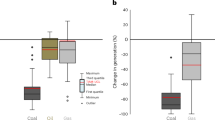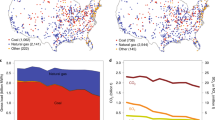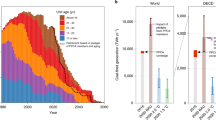Abstract
Cheap and abundant coal fuelled the industrialization of Europe, North America and Asia1. However, the price tag on coal has never reflected the external cost to society; coal combustion produces more than a third of today’s global CO2 emissions and is a major contributor to local adverse effects on the environment and public health, such as biodiversity loss and respiratory diseases. Here, we show that phasing out coal yields substantial local environmental and health benefits that outweigh the direct policy costs due to shortening of the energy supply. Phasing out coal is thus a no-regret strategy for most world regions, even when only accounting for domestic effects and neglecting the global benefits from slowing climate change. Our results suggest that these domestic effects potentially eliminate much of the free-rider problem caused by the discrepancy between the national burden of decarbonization costs and the internationally shared benefits of climate change impact mitigation. This, combined with the profound effect of closing around half of the global CO2 emissions gap towards the 2 °C target, makes coal phase-out policies attractive candidates for the iterative strengthening of the nationally determined contributions pledged by the countries under the Paris Agreement.
This is a preview of subscription content, access via your institution
Access options
Access Nature and 54 other Nature Portfolio journals
Get Nature+, our best-value online-access subscription
$29.99 / 30 days
cancel any time
Subscribe to this journal
Receive 12 print issues and online access
$209.00 per year
only $17.42 per issue
Buy this article
- Purchase on Springer Link
- Instant access to full article PDF
Prices may be subject to local taxes which are calculated during checkout



Similar content being viewed by others
Data availability
The data supporting the findings of this study are available within the paper, its supplementary information files and in the following repositories. The energy–economy–climate model REMIND is available at github.com/remindmodel/remind. The Life Cycle Assessment notebooks and data are available at github.com/rauner/holistic-coal-exit. The air pollution data is available at github.com/rauner/air-pollution.
Code availability
The code used to generate the energy–economy–climate model REMIND can be accessed at github.com/remindmodel/remind. The code used to generate the Life Cycle Assessment results can be accessed at github.com/rauner/holistic-coal-exit, at bitbucket.org/cmutel/brightway2 (Brightway2), at github.com/IndEcol/wurst (Wurst), and at github.com/Loisel/rmnd-lca (rmnd-lca). The code used to generate the air pollution results can be accessed at github.com/rauner/air-pollution.
References
Pomeranz, K. The Great Divergence (Princeton Univ. Press, 2009).
IPCC Special Report on Global Warming of 1.5 °C (eds Masson-Delmotte, V. et al.) (WMO, 2018).
LeQuéré, C. et al. Drivers of declining CO2 emissions in 18 developed economies. Nat. Clim. Change 9, 213–217 (2019).
Emissions Gap Report 2018 (UNEP, 2018).
Griggs, D. et al. Sustainable development goals for people and planet. Nature 495, 305–307 (2013).
Lloyd, W. Two Lectures on the Checks to Population: Delivered Before the University of Oxford (S. Collingwood, 1833).
Brousseau, E., Dedeurwaerdere, T., Jouvet, P.-A. & Willinger, M. in Global Environmental Commons: Analytical and Political Challenges in Building Governance Mechanisms (eds Brousseau, E. et al.) 1–28 (Oxford Univ. Press, 2012).
McGlade, C. & Ekins, P. The geographical distribution of fossil fuels unused when limiting global warming to 2 ∘C. Nature 517, 187–190 (2015).
Edenhofer, O. et al. Closing the emission price gap. Glob. Environ. Change 31, 132–143 (2015).
Jewell, J., Vinichenko, V., Nacke, L. & Cherp, A. Prospects for powering past coal. Nat. Clim. Change 9, 592–597 (2019).
McCollum, D. L., Krey, V. & Riahi, K. An integrated approach to energy sustainability. Nat. Clim. Change 1, 428–429 (2011).
Author. Sustainable development through climate action. Nat. Clim. Change 9, 491 (2019).
Riahi, K. et al. The shared socioeconomic pathways and their energy, land use, and greenhouse gas emissions implications: an overview. Glob. Environ. Change 42, 153–168 (2017).
Rogelj, J. et al. Understanding the origin of Paris Agreement emission uncertainties. Nat. Commun. 8, 15748 (2017).
Vrontisi, Z. et al. Enhancing global climate policy ambition towards a 1.5 ∘C stabilization: a short-term multi-model assessment. Environ. Res. Lett. 13, 044039 (2018).
Tong, D. et al. Committed emissions from existing energy infrastructure jeopardize 1.5 ∘C climate target. Nature 572, 373–377 (2019).
Luderer, G. et al. Residual fossil CO2 emissions in 1.5–2 ∘C pathways. Nat. Clim. Change 8, 626–633 (2018).
Luderer, G., Bertram, C., Calvin, K., De Cian, E. & Kriegler, E. Implications of weak near-term climate policies on long-term mitigation pathways. Climatic Change 136, 127–140 (2016).
Rauner, S., Hilaire, J., Klein, D., Strefler, J. & Luderer, G. Air quality co-benefits of ratcheting-up the NDCs. Climatic Change (in press).
Burnett, R. et al. Global estimates of mortality associated with long-term exposure to outdoor fine particulate matter. Proc. Natl Acad. Sci. USA 115, 9592–9597 (2018).
Wernet, G. et al. The ecoinvent database version 3 (part I): overview and methodology. Int. J. Life Cycle Assess. 21, 1218–1230 (2016).
Goedkoop, M., Heijungs, R., De Schryver, A., Struijs, J. & van Zelm, R. ReCiPe 2008: A Life Cycle Impact Assessment Method which Comprises Harmonised Category Indicators at the Midpoint and the Endpoint Level (2009).
Model Documentation - REMIND (IAMC, 2018).
Bauer, N., Baumstark, L. & Leimbach, M. The REMIND-R model: the role of renewables in the low-carbon transformation–first-best vs. second-best worlds. Climatic Change 114, 145–168 (2012).
Heijungs, R. & Suh, S. The Computational Structure of Life Cycle Assessment Vol. 11 (Springer, 2002).
Cox, B., Mutel, C. L., Bauer, C., MendozaBeltran, A. & Vuuren, D. Pvan Uncertain environmental footprint of current and future battery electric vehicles. Environ. Sci. Technol. 52, 4989–4995 (2018).
Amann, M. Greenhouse Gas and Air Pollution Interaction and Synergies (GAINS) (European Environment Agency, 2012).
Van Dingenen, R. et al. TM5-FASST: a global atmospheric source-receptor model for rapid impact analysis of emission changes on air quality and short-lived climate pollutants. Atmos. Chem. Phys. 18, 16173–16211 (2018).
Jerrett, M. et al. Long-term ozone exposure and mortality. N. Engl. J. Med. 360, 1085–1095 (2009).
WHO Mortality Database (WHO, 2012).
KC, S. & Lutz, W. The human core of the shared socioeconomic pathways: population scenarios by age, sex and level of education for all countries to 2100. Glob. Environ. Change 42, 181–192 (2017).
Global Health Estimates 2016: Deaths by Cause, Age, Sex, by Country and by Region, 2000–2016 (WHO, 2018).
Mortality Risk Valuation in Environment, Health and Transport Policies Vol. 9789264130 (OECD, 2012).
Ott, W., Baur, M. & Kaufmann, Y. Assessment of Biodiversity Losses Deliverable D.4.2 (NEEDS, 2006).
Koellner, T. Land use in product life cycles and its consequences for ecosystem quality. Int. J. Life Cycle Assess. 7, 130 (2002).
Tol, R. S. J. The economic effects of climate change. J. Econ. Perspect. 23, 29–51 (2009).
van den Bergh, J. & Botzen, W. J. W. A lower bound to the social cost of CO2 emissions. Nat. Clim. Change 4, 253–258 (2014).
Krey, V. et al. Looking under the hood: a comparison of techno-economic assumptions across national and global integrated assessment models. Energy 172, 1254–1267 (2019).
IPCC Climate Change 2014: Synthesis Report (eds Core Writing Team, Pachauri, R. K. & Meyer, L. A.) (IPCC, 2014).
Acknowledgements
The research leading to these results was supported by the ENavi (funding code 03SFK4P0), INTEGRATE (01LP1928C) and PEGASOS (01LA1826C) projects funded by the German Federal Ministry of Education and Research (BMBF).
Author information
Authors and Affiliations
Contributions
S.R., N.B. and G.L. designed the research. S.R. designed the modelling framework and performed the integrated assessment analysis. S.R. and R.V.D. performed the air pollution analysis. S.R., A.D. and C.M. performed the LCA analysis. S.R. created the figures and wrote the paper with inputs and feedback from all authors.
Corresponding author
Ethics declarations
Competing interests
The authors declare no competing interests.
Additional information
Peer review information Nature Climate Change thanks Dev Millstein and the other, anonymous, reviewer(s) for their contribution to the peer review of this work.
Publisher’s note Springer Nature remains neutral with regard to jurisdictional claims in published maps and institutional affiliations.
Supplementary information
Supplementary Information
Supplementary Figs. 1–33 and Tables 1 and 2.
Supplementary Data 1
Energy-economy-climate results including CO2 pathways and technology mixes.
Supplementary Data 2
Life cycle assessment mid-point results.
Supplementary Data 3
Life cycle assessment end-point results.
Supplementary Data 4
Life cycle assessment end-point monetized results.
Supplementary Data 5
Region-country mapping.
Rights and permissions
About this article
Cite this article
Rauner, S., Bauer, N., Dirnaichner, A. et al. Coal-exit health and environmental damage reductions outweigh economic impacts. Nat. Clim. Chang. 10, 308–312 (2020). https://doi.org/10.1038/s41558-020-0728-x
Received:
Accepted:
Published:
Issue Date:
DOI: https://doi.org/10.1038/s41558-020-0728-x
This article is cited by
-
Coal-exit alliance must confront freeriding sectors to propel Paris-aligned momentum
Nature Climate Change (2023)
-
Recent advances of two-dimensional metal-organic frameworks in alkaline electrolysis water for hydrogen production
Science China Chemistry (2023)
-
Environmental trade-offs of direct air capture technologies in climate change mitigation toward 2100
Nature Communications (2022)
-
Effects of recultivation on soil organic carbon sequestration in abandoned coal mining sites: a meta-analysis
Scientific Reports (2022)
-
The G20 emission projections to 2030 improved since the Paris Agreement, but only slightly
Mitigation and Adaptation Strategies for Global Change (2022)



